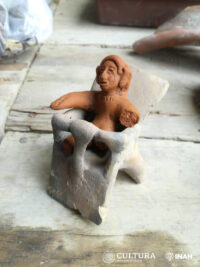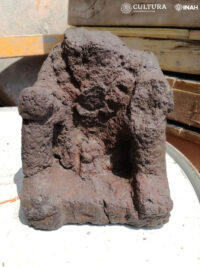 The remains of a 1,500-year-old Teotihuacan occupation village have been discovered in the Tlatelolco area of Mexico City’s historic center. Archaeologists with Mexico’s National Institute of Anthropology and History (INAH) have unearthed the remains of water channels, tamped and levelled floors, post holes, an artesian well and large numbers of ceramics. Three human burials, two adults and one child, were found containing sets of bowls with an annular base typical of Teotihuacan production. The style of the ceramics date the village to between 450 and 650 A.D., the Classic period of Teotihuacan.
The remains of a 1,500-year-old Teotihuacan occupation village have been discovered in the Tlatelolco area of Mexico City’s historic center. Archaeologists with Mexico’s National Institute of Anthropology and History (INAH) have unearthed the remains of water channels, tamped and levelled floors, post holes, an artesian well and large numbers of ceramics. Three human burials, two adults and one child, were found containing sets of bowls with an annular base typical of Teotihuacan production. The style of the ceramics date the village to between 450 and 650 A.D., the Classic period of Teotihuacan.
 The Mesoamerican metropolis of Teotihuacan was the largest city in the Americas at its peak of population and urban development in the mid-5th century A.D. Located about 25 miles northeast of modern-day Mexico City, it was the dominant influence, political, economic and cultural, of the region. Archaeologists believe the ancient village discovered in downtown Mexico City was one of several rural settlements that were self-sufficient subsistence farmers, fishers and gatherers under the sphere of economic influence of Teotihuacan.
The Mesoamerican metropolis of Teotihuacan was the largest city in the Americas at its peak of population and urban development in the mid-5th century A.D. Located about 25 miles northeast of modern-day Mexico City, it was the dominant influence, political, economic and cultural, of the region. Archaeologists believe the ancient village discovered in downtown Mexico City was one of several rural settlements that were self-sufficient subsistence farmers, fishers and gatherers under the sphere of economic influence of Teotihuacan.
The first remains of the village were discovered during construction of the Conjunto Urbano Nonoalco Tlatelolco apartment complex between 1960 and 1964. The archaeologist in charge of the excavation at that time, Francisco González Rul, hypothesized that it was a village of fishers and gatherers. This has now been confirmed by the new discoveries, but the recent finds indicate a more complex economic structure than subsistence only. They also fished and hunted surplus to their own requirements, as well as producing ceramics, weapons and carved stone, shell, obsidian and flint artifacts.
 Built on an islet of Lake Texcoco, the water channels were part of the embankment system that reclaimed land from the lake. The channels were ultimately blocked off, their canals blocked with ceramic vessels, stone objects and sculptures from the Late Aztec III (1440-1521) and Early Colonial (1521-1620) stages. This appears to have been done deliberately, as the objects were covered with a layer of small stone slabs and volcanic rocks. They blocked the channel in what archaeologists believe was an intentional closing ritual.
Built on an islet of Lake Texcoco, the water channels were part of the embankment system that reclaimed land from the lake. The channels were ultimately blocked off, their canals blocked with ceramic vessels, stone objects and sculptures from the Late Aztec III (1440-1521) and Early Colonial (1521-1620) stages. This appears to have been done deliberately, as the objects were covered with a layer of small stone slabs and volcanic rocks. They blocked the channel in what archaeologists believe was an intentional closing ritual.
 The village was likely part of Teotihuacan’s supply and trade network that brought in food from the outlying countryside to supply its enormous population (more than 150,000 at its zenith). The settlement also saw later occupation. All told, the excavation revealed remains from six periods: after Teotihuacan’s collapse, there was a Mexica occupation in the Late Postclassic (1338-1521) and Early Colonial periods (1521-1620) and four occupation layers after that (one in the 18th century, one in the 19th and two in the 20th century).
The village was likely part of Teotihuacan’s supply and trade network that brought in food from the outlying countryside to supply its enormous population (more than 150,000 at its zenith). The settlement also saw later occupation. All told, the excavation revealed remains from six periods: after Teotihuacan’s collapse, there was a Mexica occupation in the Late Postclassic (1338-1521) and Early Colonial periods (1521-1620) and four occupation layers after that (one in the 18th century, one in the 19th and two in the 20th century).
* This article was originally published here










No comments:
Post a Comment